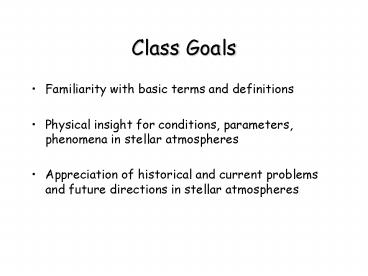Class Goals - PowerPoint PPT Presentation
1 / 13
Title:
Class Goals
Description:
Physical insight for conditions, parameters, phenomena in stellar atmospheres ... Solar granulation. Basic Physics Ideal Gas Law. PV=nRT or P=NkT where N=r/m ... – PowerPoint PPT presentation
Number of Views:10
Avg rating:3.0/5.0
Title: Class Goals
1
Class Goals
- Familiarity with basic terms and definitions
- Physical insight for conditions, parameters,
phenomena in stellar atmospheres - Appreciation of historical and current problems
and future directions in stellar atmospheres
2
History of Stellar Atmospheres
- Cecelia Payne Gaposchkin wrote the first PhD
thesis in astronomy at Harvard - She performed the first analysis of the
composition of the Sun (she was mostly right,
except for hydrogen). - What method did she use?
- Note limited availability of atomic data in the
1920s
3
Useful References
- Astrophysical Quantities
- Holweger Mueller 1974, Solar Physics, 39, 19
Standard Model - MARCS model grid (Bell et al., AAS, 1976, 23,
37) - Kurucz (1979) models ApJ Suppl., 40, 1
- Stellar Abundances Grevesse Sauval 1998,
Space Science Reviews, 85, 161 or Anders
Grevesse 1989, Geochem. Cosmochim. Acta, 53,
197 - Solar gf values Thevenin 1989 (AAS, 77, 137)
and 1990 (AAS, 82, 179)
4
What Is a Stellar Atmosphere?
- Basic Definition The transition between the
inside and the outside of a star - Characterized by two parameters
- Effective temperature NOT a real temperature,
but rather the temperature needed in 4pR2T4 to
match the observed flux at a given radius - Surface gravity log g (note that g is not a
dimensionless number!) - Log g for the Earth is 3.0 (103 cm/s2)
- Log g for the Sun is 4.4
- Log g for a white dwarf is 8
- Log g for a supergiant is 0
5
Class Problem
- During the course of its evolution, the Sun will
pass from the main sequence to become a red
giant, and then a white dwarf. - Estimate the radius of the Sun in both phases,
assuming log g 1.0 when the Sun is a red giant,
and log g8 when the Sun is a white dwarf.
Assume no mass loss. - Give the answer in both units of the current
solar radius and in cgs or MKS units.
6
Basic Assumptions in Stellar Atmospheres
- Local Thermodynamic Equilibrium
- Ionization and excitation correctly described by
the Saha and Boltzman equations, and photon
distribution is black body - Hydrostatic Equilibrium
- No dynamically significant mass loss
- The photosphere is not undergoing large scale
accelerations comparable to surface gravity - No pulsations or large scale flows
- Plane Parallel Atmosphere
- Only one spatial coordinate (depth)
- Departure from plane parallel much larger than
photon mean free path - Fine structure is negligible (but see the Sun!)
7
Solar granulation
8
Basic Physics Ideal Gas Law
- PVnRT or PNkT where Nr/m
- P pressure (dynes cm-2)
- V volume (cm3)
- N number of particles per unit volume
- r density of gm cm-3
- n number of moles of gas
- R Rydberg constant (8.314 x 107 erg/mole/K)
- T temperature in Kelvin
- k Boltzmans constant (1.38 x 1016 erg/K)
- m mean molecular weight in AMU (1 AMU 1.66 x
10-24 gm)
9
Class Problem
- Using the ideal gas law, estimate the number
density of atoms in the Suns photosphere and in
the Earths atmosphere at sea level. For the
Sun, assume T5000K, P105 dyne cm-2. How do the
densities compare?
10
Basic Physics Thermal Velocity Distributions
- RMS Velocity (3kT/m)1/2
- Class Problem What are the RMS velocities of
7Li, 16O, 56Fe, and 137Ba in the solar
photosphere (assume T5000K). - How would you expect the width of the Li
resonance line to compare to a Ba line?
11
Basic Physics the Boltzman Equation
- Nn (gn/u(T))e-Xn/kT
- Where u(T) is the partition function, gn is
the statistical weight, and Xn is the excitation
potential. For back-of-the-envelope
calculations, this equation is written as - Nn/N (gn/u(T)) x 10 QXn
- Note here also the definition of Q 5040/T
(log e)/kT with k in units of electron volts
per degree, since X is in electron volts.
Partition functions can be found in an appendix
in the text.
12
Basic Physics The Saha Equation
- The Saha equation describes the ionization
of atoms (see the text for the full equation).
For hand calculation purposes, a shortened form
of the equation can be written as follows - N1/ N0 (1/Pe) x 1.202 x 109 (u1/u0) x T5/2 x
10QI - Pe is the electron pressure and I is the
ionization potential in ev. Again, u0 and u1 are
the partition functions for the ground and first
excited states. Note that the amount of
ionization depends inversely on the electron
pressure the more loose electrons there are,
the less ionization there will be.
13
Class Problems
- At (approximately) what Teff is Fe 50 ionized in
a main sequence star? In a supergiant? - What is the dominant ionization state of Li in a
K giant at 4000K? In the Sun? In an A star at
8000K?































